Understanding psychological theories for motivation can unlock potential, enhance resilience, and foster growth. Key frameworks like Maslow’s Hierarchy of Needs, Self-Determination Theory, and Expectancy Theory provide insights into how needs and intrinsic motivation influence behaviour. These theories emphasize the importance of fulfilling basic needs, the role of autonomy, and the impact of expected outcomes on motivation. By applying these principles, individuals can effectively pursue personal development and achieve their goals.
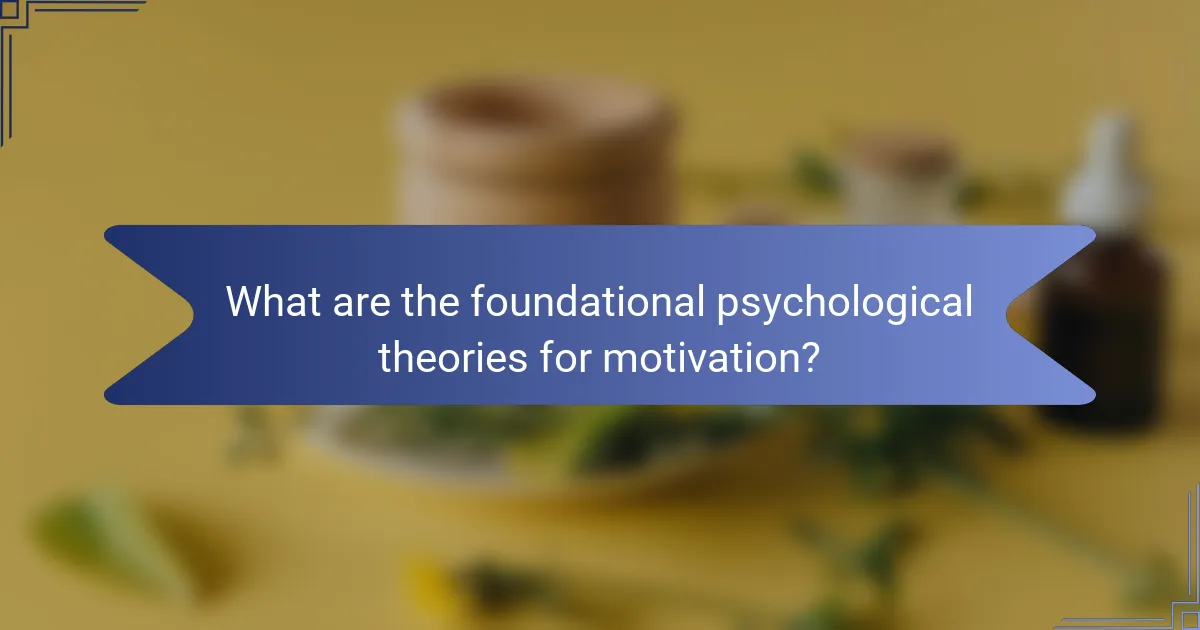
What are the foundational psychological theories for motivation?
Psychological theories for motivation include Maslow’s Hierarchy of Needs, Self-Determination Theory, and Expectancy Theory. These frameworks highlight how needs, intrinsic motivation, and expected outcomes drive human behaviour.
Maslow’s Hierarchy of Needs categorises motivation into five levels: physiological, safety, love/belonging, esteem, and self-actualisation. This model illustrates how individuals prioritise needs, influencing their motivation levels.
Self-Determination Theory emphasizes the role of intrinsic motivation, focusing on autonomy, competence, and relatedness. It suggests that fulfilling these psychological needs enhances motivation and well-being.
Expectancy Theory posits that motivation is influenced by the expected outcomes of actions. It asserts that individuals are motivated to act if they believe their efforts will lead to desired results.
How do Maslow’s Hierarchy of Needs influence personal development?
Maslow’s Hierarchy of Needs significantly influences personal development by providing a framework for understanding human motivation. The theory outlines five levels of needs: physiological, safety, love/belonging, esteem, and self-actualisation. As individuals satisfy lower-level needs, they can focus on higher-level needs, fostering growth and resilience.
Understanding this hierarchy helps individuals identify their current needs and prioritise personal development efforts. For example, someone struggling with basic physiological needs may find it challenging to pursue self-esteem or self-actualisation. This insight encourages targeted strategies for personal growth.
The framework also emphasizes that motivation is dynamic. As individuals achieve goals at one level, they may shift focus to the next, continuously enhancing their potential. This progression highlights the importance of resilience in overcoming challenges to fulfil higher-level needs.
By applying Maslow’s theory, individuals can create personalised development plans that align with their current needs, ultimately leading to a more fulfilling and motivated life.
What role does Self-Determination Theory play in enhancing motivation?
Self-Determination Theory enhances motivation by emphasizing autonomy, competence, and relatedness. These core components foster intrinsic motivation, leading to greater engagement and persistence in activities. Research shows that when individuals feel in control of their actions, they are more likely to pursue goals effectively. Autonomy supports personal choice, competence builds confidence through mastery, and relatedness nurtures social connections, creating a holistic motivational environment. This theory has been applied in various settings, including education and the workplace, demonstrating its unique ability to unlock potential and enhance resilience.
How can Goal-Setting Theory be applied for personal growth?
Goal-Setting Theory can significantly enhance personal growth by providing a structured approach to achieving goals. By setting specific, measurable, achievable, relevant, and time-bound (SMART) goals, individuals can focus their efforts and increase motivation. This theory emphasizes the importance of goal clarity, which leads to higher performance and greater resilience in overcoming challenges. As a result, individuals experience a sense of accomplishment that fosters continuous growth and self-improvement.
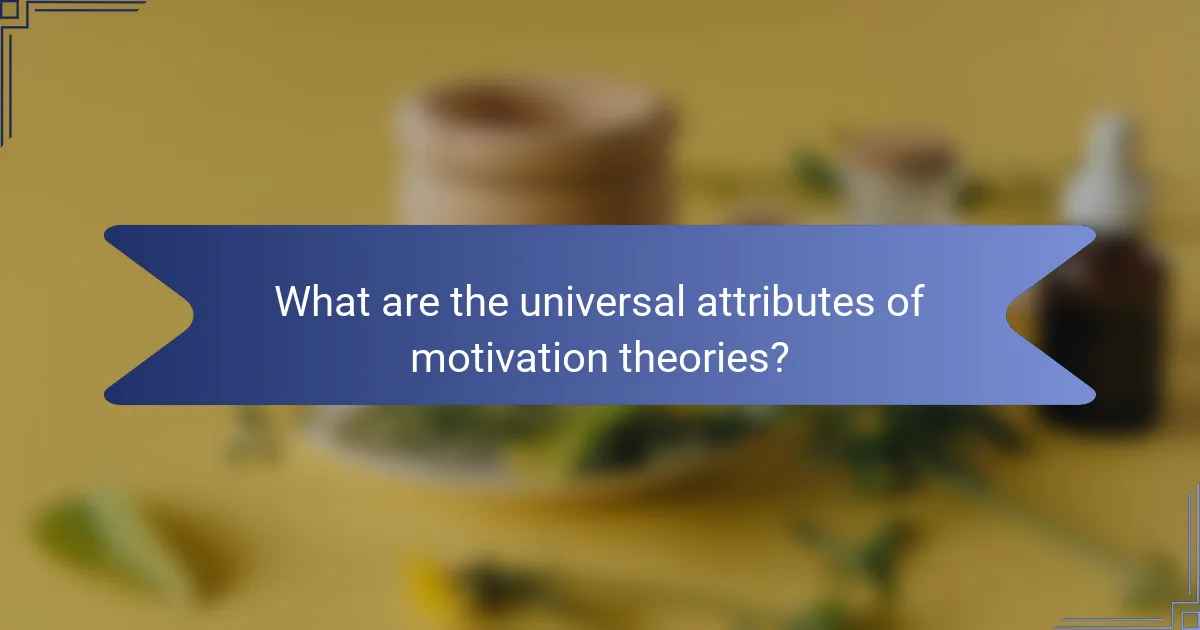
What are the universal attributes of motivation theories?
Motivation theories universally emphasize intrinsic and extrinsic factors influencing behaviour. Key attributes include needs, goals, and rewards that drive individuals toward achieving their potential. Theories like Maslow’s hierarchy highlight the importance of fulfilling basic needs before pursuing higher-level aspirations. Additionally, self-determination theory underscores the role of autonomy, competence, and relatedness in fostering motivation. Understanding these attributes can enhance resilience and promote personal growth across various contexts.
How does intrinsic motivation differ from extrinsic motivation?
Intrinsic motivation drives behaviour from internal satisfaction, while extrinsic motivation relies on external rewards. Intrinsic motivation fosters creativity and persistence, enhancing personal growth. In contrast, extrinsic motivation can lead to short-term compliance but may undermine intrinsic interest over time. Understanding these distinctions helps individuals leverage both types effectively for optimal performance and resilience.
What psychological needs are universally recognized in motivation?
Universal psychological needs recognized in motivation include autonomy, competence, and relatedness. These needs drive behaviour and influence personal growth. Autonomy refers to the desire for control over one’s actions. Competence involves the need to feel effective in one’s activities. Relatedness emphasizes the importance of social connections and belonging. Understanding these needs enhances motivation and fosters resilience.
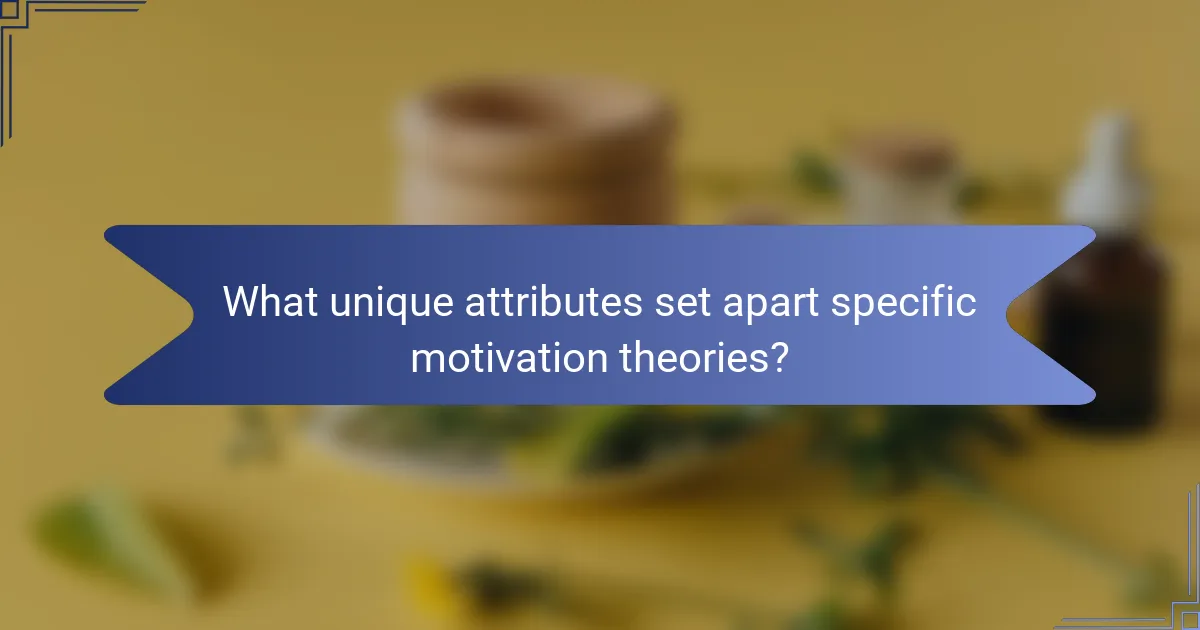
What unique attributes set apart specific motivation theories?
Unique attributes of specific motivation theories include their foundational principles, applicability across contexts, and focus on different aspects of human behaviour. For instance, Maslow’s Hierarchy of Needs emphasizes the progression through needs, while Self-Determination Theory highlights intrinsic versus extrinsic motivation. Each theory offers distinct insights, such as the emphasis on autonomy in Self-Determination Theory, which is a unique attribute that fosters deeper engagement and resilience. Understanding these differences enhances the application of motivation theories in various settings, from education to workplace environments.
How does the Expectancy Theory explain individual motivation levels?
Expectancy Theory explains that individual motivation levels depend on the perceived likelihood of achieving desired outcomes. This theory posits that motivation is a product of three key components: expectancy, instrumentality, and valence. Expectancy refers to the belief that effort will lead to performance; instrumentality is the belief that performance will lead to a reward; and valence is the value placed on that reward. Together, these components create a motivational force that drives behaviour towards achieving goals. Understanding these elements can enhance individual resilience and facilitate personal growth.
What is the significance of the Achievement Motivation Theory?
Achievement Motivation Theory is significant because it explains how individuals are driven to achieve goals, enhancing personal growth and resilience. This theory emphasizes the role of intrinsic and extrinsic motivations in goal-setting and achievement. It identifies key attributes, such as the desire for mastery, the importance of feedback, and the impact of social comparisons. Understanding these dynamics can lead to improved educational practices and workplace environments, fostering a culture of achievement. As a result, applying this theory can unlock potential and encourage continuous development.
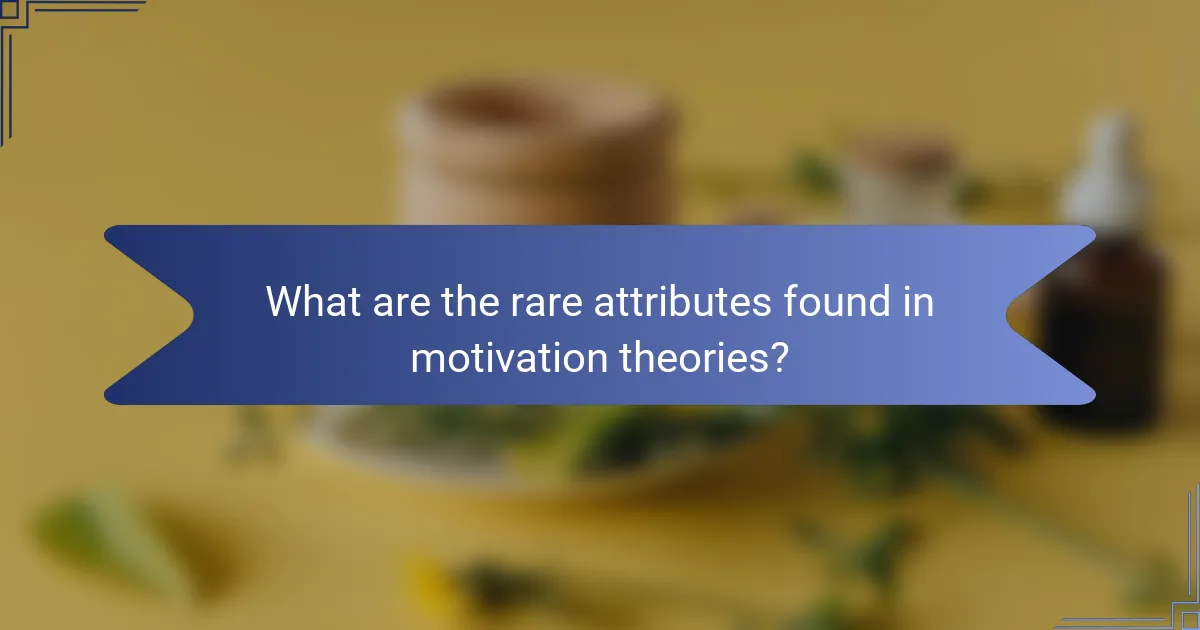
What are the rare attributes found in motivation theories?
Motivation theories often highlight rare attributes that provide unique insights into human behaviour. One such rare attribute is the concept of intrinsic motivation, which emphasizes personal satisfaction and internal rewards over external incentives. Another rare attribute is the role of psychological safety, where individuals feel secure to take risks and express themselves without fear of negative consequences. Additionally, the interplay between motivation and emotional intelligence is often overlooked, yet it significantly influences how individuals engage with their goals. These rare attributes deepen the understanding of motivation, offering a more nuanced perspective on driving human behaviour.
How does the Dual Process Theory of motivation function?
The Dual Process Theory of motivation operates through two distinct systems: the automatic and the reflective. The automatic system drives immediate responses and emotional reactions, while the reflective system engages in conscious thought and decision-making. This interplay influences how individuals pursue goals and respond to challenges. Understanding this theory enhances resilience by promoting awareness of motivational drivers.
What insights does the Flow Theory provide for personal resilience?
Flow Theory provides insights that enhance personal resilience by promoting an optimal state of engagement and focus. This theory highlights the balance between challenge and skill, enabling individuals to experience deep concentration and satisfaction. When individuals achieve flow, they develop greater resilience through improved coping strategies and motivation. This state fosters a sense of control, allowing individuals to navigate challenges more effectively. As a result, Flow Theory serves as a valuable framework for enhancing personal resilience and overall well-being.
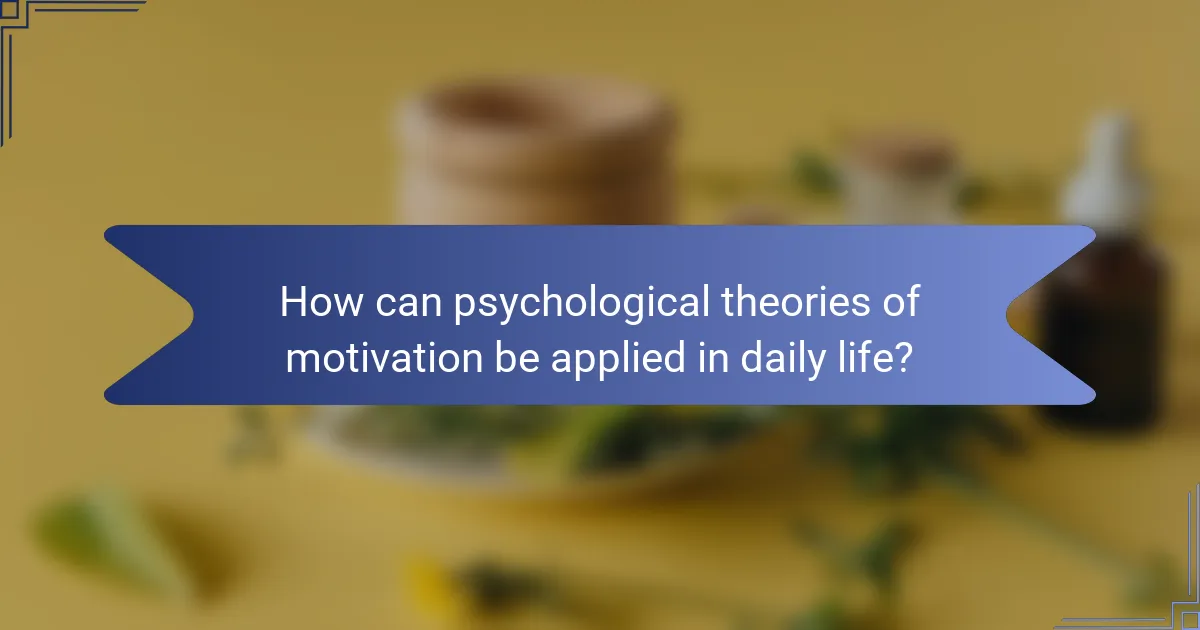
How can psychological theories of motivation be applied in daily life?
Psychological theories of motivation can enhance daily life by providing frameworks for personal growth and resilience. Applying Maslow’s hierarchy of needs helps prioritise goals, ensuring basic needs are met before pursuing higher aspirations. Self-determination theory emphasizes intrinsic motivation, encouraging individuals to engage in activities that align with their values. Goal-setting theory aids in creating specific, measurable objectives, fostering accountability and progress tracking. Utilizing these theories can unlock potential, enhance resilience, and foster growth in various life aspects.
What techniques can enhance intrinsic motivation effectively?
To enhance intrinsic motivation effectively, techniques such as fostering autonomy, providing meaningful feedback, and connecting tasks to personal values are essential. Autonomy empowers individuals to make choices, increasing their engagement. Meaningful feedback helps individuals recognize progress, reinforcing their efforts. Connecting tasks to personal values ensures that activities resonate on a deeper level, enhancing commitment.
How can understanding motivation theories improve resilience?
Understanding motivation theories enhances resilience by providing frameworks to navigate challenges effectively. These theories, such as Maslow’s hierarchy of needs and self-determination theory, highlight the importance of intrinsic motivation, which fosters perseverance. For instance, individuals who comprehend their intrinsic motivations are more likely to set meaningful goals, leading to increased resilience in the face of adversity. By recognizing their motivations, people can develop coping strategies that align with their personal values, thereby strengthening their ability to overcome obstacles. Ultimately, this deeper understanding cultivates a growth mindset, empowering individuals to adapt and thrive.
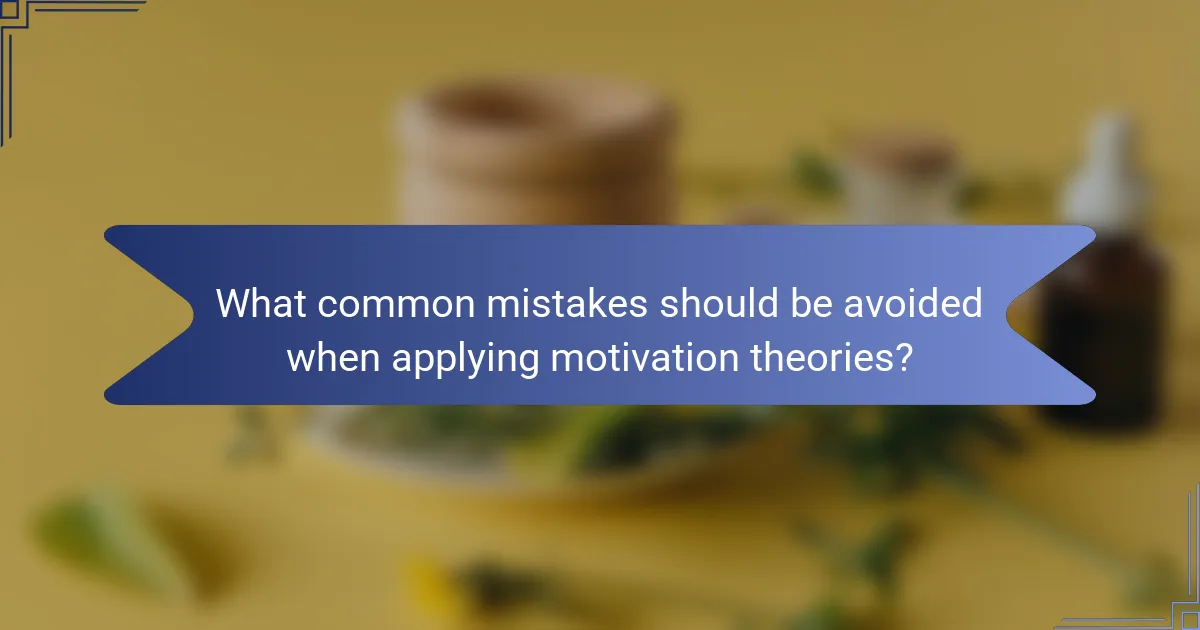
What common mistakes should be avoided when applying motivation theories?
To effectively apply motivation theories, avoid common mistakes that hinder their implementation. One crucial error is neglecting individual differences; motivation varies greatly among people. Another mistake is applying theories rigidly without adapting them to specific contexts. Failing to integrate feedback mechanisms can also diminish the effectiveness of motivation strategies. Lastly, overlooking the importance of intrinsic motivation can lead to short-lived results.
How can individuals ensure they are setting achievable goals?
Individuals can ensure they are setting achievable goals by applying specific psychological theories for motivation. Start by defining clear, realistic objectives based on personal strengths and resources. Use the SMART criteria—Specific, Measurable, Achievable, Relevant, Time-bound—to refine these goals. Break larger goals into smaller, manageable tasks to foster a sense of progress and maintain motivation. Regularly review and adjust goals based on feedback and personal growth. This approach enhances resilience and encourages continuous development.
What are the best practices for fostering a growth mindset?
To foster a growth mindset, encourage continuous learning, embrace challenges, and view failures as opportunities. Promote self-reflection and set achievable goals. Provide constructive feedback and celebrate effort over results. Cultivate a supportive environment that values persistence and resilience.
What expert insights can guide effective application of motivation theories?
Expert insights for applying motivation theories effectively include understanding individual differences, leveraging intrinsic motivation, and fostering a growth mindset. Recognising that each person is motivated by unique factors allows for tailored approaches. For instance, intrinsic motivation enhances engagement and persistence, which are crucial for achieving long-term goals. Additionally, promoting a growth mindset encourages resilience, enabling individuals to view challenges as opportunities for development. Integrating these insights can lead to more effective strategies in various settings, from education to workplace environments.